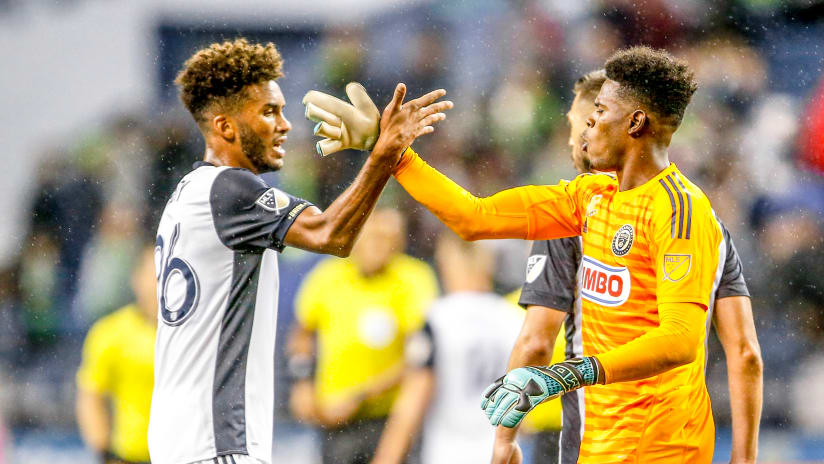For the past three seasons, Philadelphia Union have adhered quite strictly to a consistent philosophy focused on possession, organized pressure, and playing through central midfield. The execution has been variable at times, but with Borek Dockal, Ale Bedoya, and Haris Medunjanin in midfield, the appropriate defenders to play a high line in back, and options on the wing, things have looked consistent week to week this season.
And New England’s approach against the Union on Saturday points to the power of trusting a philosophy as a guide. Brad Friedel looked at the Union, looked at his team, and decided that the best way to secure points on the road was to go to tight man-marking in midfield, mimicking the approach that Chicago used in both of their visits to Talen Energy Stadium this season. In short, the Union are executing at a high level now, and opponents are taking fairly drastic measures to try and contain Philly’s midfield.
Since taking over, Friedel’s calling card has been a high, zonal press that aims to catch defenders with their metaphorical pants down. Four players commit high, often in a diamond shape, and try to push the ball toward one side of the pitch, leaving a passing lane to the center open. One of the two deeper midfielders is preying on that open man, and when the ball is played it, a Planet-Earth-type attack occurs with the hope of knocking the ball loose.
Throw all that out the window, though. On Saturday, it was just: Where are the midfielders? Cool — get into their back pockets and stay there. Haris Medunjanin’s forceful celebration after Cory Burke’s goal was his response to feeling like the Revs believed they could successfully keep him out of the game by attaching a Luis Caicedo to his back. After being harried for over 50 minutes straight, Medunjanin got his one moment and made the most of it, just like Dockal did against Chicago back on May 30 when he set up Ilsinho’s opener.
Consequences of man
The man-marking approach once again left the Union’s central defenders with time on the ball, though New England did not sit as deep as Chicago, instead preferring to close space from wide when Auston Trusty and Jack Elliott advanced the ball.
Another quirk of New England’s version of the man-marking defense is that Friedel kept his back like scheme the same, meaning defenders tried to stay as a unit and didn’t stride out of the back line following players as Union defenders often will. This meant there was space on the flanks at times, but not much access from the flank to the middle because of the tight central marking.
Philly attempted to create space for the midfielders by keeping Fafa Picault wide while tucking CJ Sapong inside so Keegan Rosenberry could step forward. Man-marking in midfield meant that if Philly’s mids moved out of a space, it was just empty. Sapong could tuck into the right channel when it opened up and often find it abandoned. With Bedoya seeking the ball by coming deep, it was Sapong and Dockal who combined more often in advanced areas on the right prior to Burke’s goal.
Giving up control
One major consequence of man-marking is that it can leave you in a fairly ugly shape when you finally win the ball back. This happened to Chicago, but they didn’t care very much since everything they wanted to do involved getting the ball to Bastian Schweinsteiger. In contrast, New England’s shape when they won the ball back was often dire, and they had few connections through which to build attacks. Their midfielders combined to complete two passes into the attacking third and two passes in the attacking third prior to Burke’s goal, and creative hub Diego Fagundez completed two passes into the final third and zero within the final third prior to the goal.
In sum, the Union are now making teams adjust to stop them, and that’s one of the end goals of controlling a game: Eventually, you begin to exercise some level of control over how other teams plan for a game, and that means you can continue to build your philosophy and add complexity while opponents just scrap for points. This is what Toronto FC did last season. A well-developed philosophy allowed Greg Vanney to make tweaks game by game without ever moving away from his principles. The execution was so good that opponents had to adjust to TFC, and this often meant learning something new just for a single match.
For goodness Blake
Andre Blake has gone from elite shot stopper to a far more complete goalie without many hiccups in between. He has become dominant in the air, and now he has had to become the leader of a young defense that performed well enough to keep the Union in the playoff hunt until the offense came online.
But until Saturday, there had not been a match in which the Union goalie really had to save his team’s skin. Philly had won a few games 2-0, but this was their first 1-0 win, and Blake stood on his head to get it. He was alert to attack Trusty’s soft back pass in the first half, then he was outstanding keeping Cristian Penilla and Juan Agudelo off the board in the second frame.
DC United is unlikely to man-mark the Union. Instead, they will seek to own the ball so their defensively lax attacking midfielder doesn’t become an issue against Philly’s dominant central trio. As New England’s setup showed, Dockal, Medunjanin, and Bedoya are now good enough to control a game before it starts, and now they have a chance to do it on the road and be the second team to knock off DC United at Audi Field.













